大学英语口语课程教学大纲
英语口语教学大纲模板
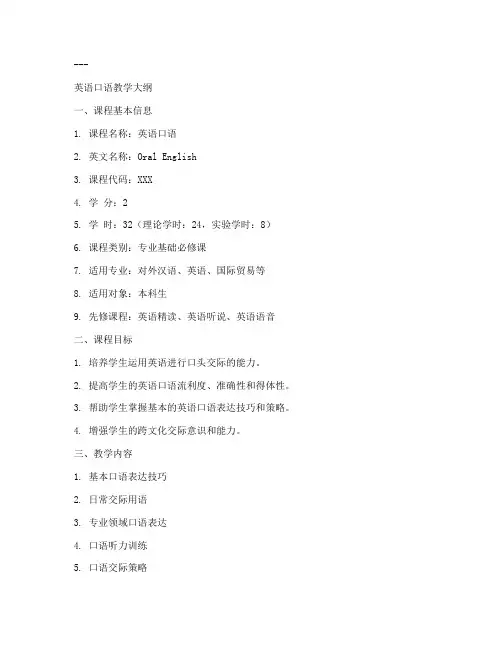
---英语口语教学大纲一、课程基本信息1. 课程名称:英语口语2. 英文名称:Oral English3. 课程代码:XXX4. 学分:25. 学时:32(理论学时:24,实验学时:8)6. 课程类别:专业基础必修课7. 适用专业:对外汉语、英语、国际贸易等8. 适用对象:本科生9. 先修课程:英语精读、英语听说、英语语音二、课程目标1. 培养学生运用英语进行口头交际的能力。
2. 提高学生的英语口语流利度、准确性和得体性。
3. 帮助学生掌握基本的英语口语表达技巧和策略。
4. 增强学生的跨文化交际意识和能力。
三、教学内容1. 基本口语表达技巧2. 日常交际用语3. 专业领域口语表达4. 口语听力训练5. 口语交际策略6. 跨文化交际四、教学方法1. 案例分析法2. 角色扮演法3. 小组讨论法4. 情景模拟法5. 任务型教学法6. 观看视频、音频资料等五、教材与参考书目1. 教材:- 《英语口语教程》,姚保慧主编,高教出版社- 《剑桥流利英语口语》4册,祁尧珊编译,外语教学与研究出版社2. 参考书目:- 《英语中级口语》,吴祯福主编,外语教学与研究出版社- 《英语口语大全》,梁成锦编著,外语教学与研究出版社- 《通俗美语会话》,杨芳林、杨学义编译,外语教学与研究出版社 - 《美国口语思维》,朱红梅、高山编著,中山大学出版社- 《英语口语句型》,陈昆才编著,广州市科学技术大学出版社六、考核方式1. 课堂表现(30%)2. 口语测试(40%)3. 作业完成情况(20%)4. 期末考试(10%)七、教学进度安排(根据具体教学计划填写)八、课程特色1. 注重实践,强调学生口语实际运用能力的培养。
2. 结合实际情境,提高学生的跨文化交际能力。
3. 采用多种教学方法,激发学生的学习兴趣。
---请注意,这只是一个模板,实际的教学大纲需要根据具体的教学环境、学生水平和教学目标进行定制。
英语口语课程教学大纲(共五篇)
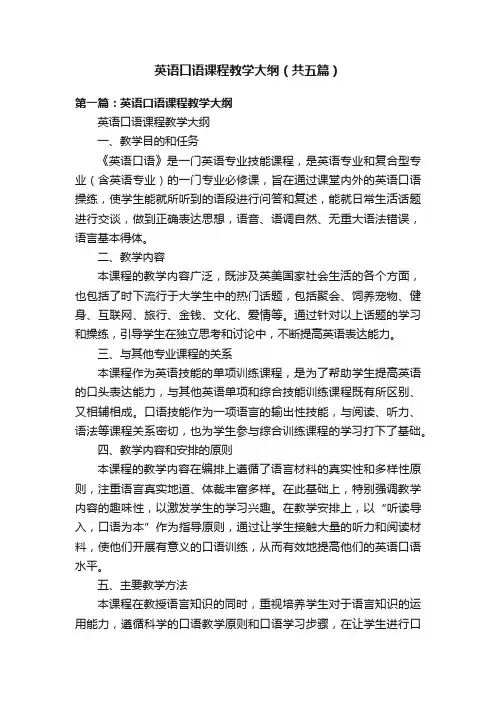
英语口语课程教学大纲(共五篇)第一篇:英语口语课程教学大纲英语口语课程教学大纲一、教学目的和任务《英语口语》是一门英语专业技能课程,是英语专业和复合型专业(含英语专业)的一门专业必修课,旨在通过课堂内外的英语口语操练,使学生能就所听到的语段进行问答和复述,能就日常生活话题进行交谈,做到正确表达思想,语音、语调自然、无重大语法错误,语言基本得体。
二、教学内容本课程的教学内容广泛,既涉及英美国家社会生活的各个方面,也包括了时下流行于大学生中的热门话题,包括聚会、饲养宠物、健身、互联网、旅行、金钱、文化、爱情等。
通过针对以上话题的学习和操练,引导学生在独立思考和讨论中,不断提高英语表达能力。
三、与其他专业课程的关系本课程作为英语技能的单项训练课程,是为了帮助学生提高英语的口头表达能力,与其他英语单项和综合技能训练课程既有所区别、又相辅相成。
口语技能作为一项语言的输出性技能,与阅读、听力、语法等课程关系密切,也为学生参与综合训练课程的学习打下了基础。
四、教学内容和安排的原则本课程的教学内容在编排上遵循了语言材料的真实性和多样性原则,注重语言真实地道、体裁丰富多样。
在此基础上,特别强调教学内容的趣味性,以激发学生的学习兴趣。
在教学安排上,以“听读导入,口语为本”作为指导原则,通过让学生接触大量的听力和阅读材料,使他们开展有意义的口语训练,从而有效地提高他们的英语口语水平。
五、主要教学方法本课程在教授语言知识的同时,重视培养学生对于语言知识的运用能力,遵循科学的口语教学原则和口语学习步骤,在让学生进行口头表达之前先让其接触大量的听力和阅读材料,然后让其通过跟读单词、回答问题、复述材料、背诵课文、自由讨论等丰富多彩的操练逐渐达到口语交际的最高阶段。
本课程采取“ 教师指导下的网络课堂学习和学生自主学习交替进行”的教学模式,要求学生通过课堂教学和课外自主学习网络课件,完成本课程的学习。
六、课时安排每周 2学时,一学期16周。
英语口语1教学大纲(具体)

英语口语1教学大纲(具体)英语口语1教学大纲《英语口语1》教学大纲课程名称:英语口语1课程时长:16周,每周4节授课人:张老师课程目标:本课程的目标是让学生掌握基本的英语口语技能,包括发音、语音语调、口语表达和听力理解。
授课内容:主题1:自我介绍与问候内容:学生将学习如何介绍自己、问候他人、感谢和道歉等基本口语表达。
教学方法:课堂讲解、听力训练、口语练习、小组讨论。
教学资源:课本、录音带、教学视频。
评估方法:课堂表现、口语练习、小组讨论。
主题2:家庭与朋友内容:学生将学习如何谈论家庭和朋友,包括家庭成员关系、朋友关系、喜好等。
教学方法:课堂讲解、听力训练、口语练习、小组讨论。
教学资源:课本、录音带、教学视频。
评估方法:课堂表现、口语练习、小组讨论。
主题3:学校生活内容:学生将学习如何谈论学校生活,包括课程、老师、同学、校园活动等。
教学方法:课堂讲解、听力训练、口语练习、小组讨论。
教学资源:课本、录音带、教学视频。
评估方法:课堂表现、口语练习、小组讨论。
英语口语教学大纲英语口语教学大纲可能因课程类型、教学目标和教学时长等因素而有所不同,以下是一个可能的英语口语教学大纲:1.课程目标:通过本课程的学习,学生应能够:__掌握基本的英语口语表达和交流技巧;__能够进行日常交流和简单的商务、学术或工作场合的交流;__了解英语口语的文化背景和语言习惯。
2.教学内容:__基础英语口语表达:包括问候、自我介绍、表达需求、询问、提供信息、道别等基本用语;__日常交流:包括购物、交通、旅游、学校生活等话题;__商务和职业场景:包括商务会议、面试、产品介绍等场景;__学术场景:包括论文写作、报告展示、学术讨论等场景;__文化背景和语言习惯:包括了解英语国家的历史、文化、风俗习惯等,以及了解英语口语的语言习惯和发音规则。
3.教学方法:__互动式教学模式:鼓励学生积极参与课堂讨论和练习,通过互动和交流提高口语表达能力;__语言实践模式:注重语言实践,通过大量的口语练习和角色扮演等方式提高学生的口语表达能力;__多媒体教学:利用多媒体资源,包括视频、音频、图片等,帮助学生更好地理解和掌握英语口语。
大学英语口语教学大纲
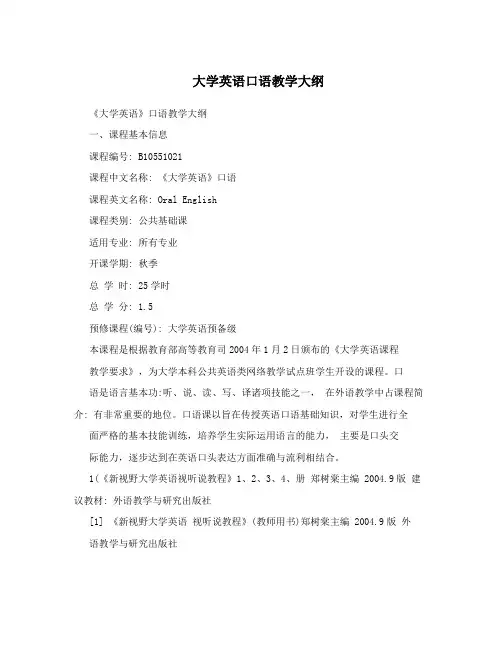
大学英语口语教学大纲《大学英语》口语教学大纲一、课程基本信息课程编号: B10551021课程中文名称: 《大学英语》口语课程英文名称: Oral English课程类别: 公共基础课适用专业: 所有专业开课学期: 秋季总学时: 25学时总学分: 1.5预修课程(编号): 大学英语预备级本课程是根据教育部高等教育司2004年1月2日颁布的《大学英语课程教学要求》,为大学本科公共英语类网络教学试点班学生开设的课程。
口语是语言基本功:听、说、读、写、译诸项技能之一,在外语教学中占课程简介: 有非常重要的地位。
口语课以旨在传授英语口语基础知识,对学生进行全面严格的基本技能训练,培养学生实际运用语言的能力,主要是口头交际能力,逐步达到在英语口头表达方面准确与流利相结合。
1(《新视野大学英语视听说教程》1、2、3、4、册郑树棠主编 2004.9版建议教材: 外语教学与研究出版社[1] 《新视野大学英语视听说教程》(教师用书)郑树棠主编 2004.9版外语教学与研究出版社参考书: [2]《新视野大学英语视听说教程》1、2、3、4、册郑树棠主编2004.9版外语教学与研究出版社二、课程教学目的本课程的教学目的是通过大量的口语练习和实践,在本课程结束时,学生能就日常生活中的一般情景进行恰当的交谈,能就社会生活中的一般话题进行连贯的发言,要求能确切表达思想,语音语法基本正确,语言基本得体。
三、理论教学内容与基本要求教学原则与方法,、课堂练口语,课下练听力以培养学生全面的语言综合能力为目标,重点培养学生的创新精神和创造能力,在必要的语言技能的基本训练以外,加强学生运用语言知识分析、综合的能力。
课堂教学以口语训练为主,形式包括分组讨论,双人问答,角色扮演,演讲等。
由于学生可上网自主学习,听力部分学生利用校园网教学平台自主学习,教师监控管理并就学生提出的问题进行网上答1疑。
,、提高学生口头交际能力本课程的基本手段是通过让学生接触到大量的文字及听力材料,增加语言输入,然后经过对语言的模仿最终达到对语言的自如运用。
《大学英语口语II》课程大纲
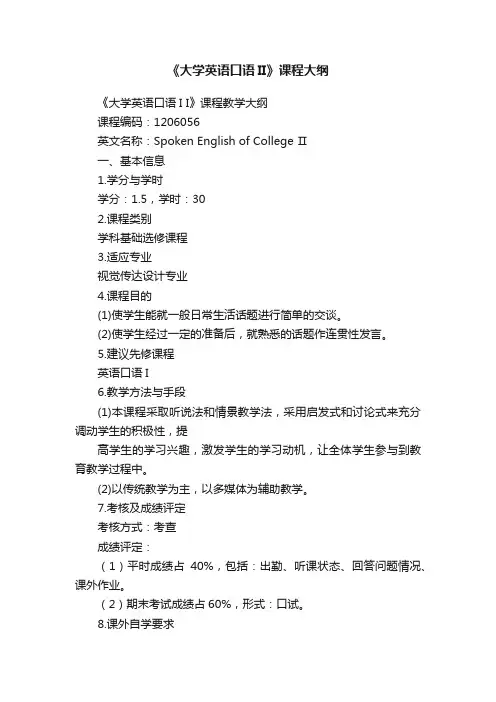
《大学英语口语II》课程大纲《大学英语口语I I》课程教学大纲课程编码:1206056英文名称:Spoken English of College Ⅱ一、基本信息1.学分与学时学分:1.5,学时:302.课程类别学科基础选修课程3.适应专业视觉传达设计专业4.课程目的(1)使学生能就一般日常生活话题进行简单的交谈。
(2)使学生经过一定的准备后,就熟悉的话题作连贯性发言。
5.建议先修课程英语口语I6.教学方法与手段(1)本课程采取听说法和情景教学法,采用启发式和讨论式来充分调动学生的积极性,提高学生的学习兴趣,激发学生的学习动机,让全体学生参与到教育教学过程中。
(2)以传统教学为主,以多媒体为辅助教学。
7.考核及成绩评定考核方式:考查成绩评定:(1)平时成绩占40%,包括:出勤、听课状态、回答问题情况、课外作业。
(2)期末考试成绩占60%,形式:口试。
8.课外自学要求(1)课前准备充分。
(2)课后多朗读、多模仿、多听录音,加强对相关文化背景知识的学习。
9.推荐教材和主要参考书目推荐教材:《英语口语教程2》(第2版).姚保慧主编. 高等教育出版社.2002年参考书目:(1)《大学英语口语》上、下册.贾正选主编.中国社会科学出版社. 2000年(2)《365天英语口语大全》耿小辉,昂秀主编.中国和平音像电子出版社,天津科学技术出版社.2010年(3)《新编实用英语口语》党晨华主编.复旦大学出版社.2009年(4)《新世纪英语口语教程(功能与语境)》李华东等主编.外语教学与研究出版社.2009年(5)《英语口语教材系列》张淑芳,黄欣编.中山大学出版社.2013年(6)《新理念英语口语互动教程》张雪珍主编.上海交通大学出版社.2010年二、主要教学内容和教学要求Unit 10 Approval and Disapproval(4学时)基本内容:(1)Way to Speak(2)Challenge to Speak(3)Topic to Discuss:Money(4)Fun to Speak:The Happiest Day of My Life基本要求:(1)了解英语中表示赞同和否定的词汇及基本表达方式。
大学英语口语课程教学大纲
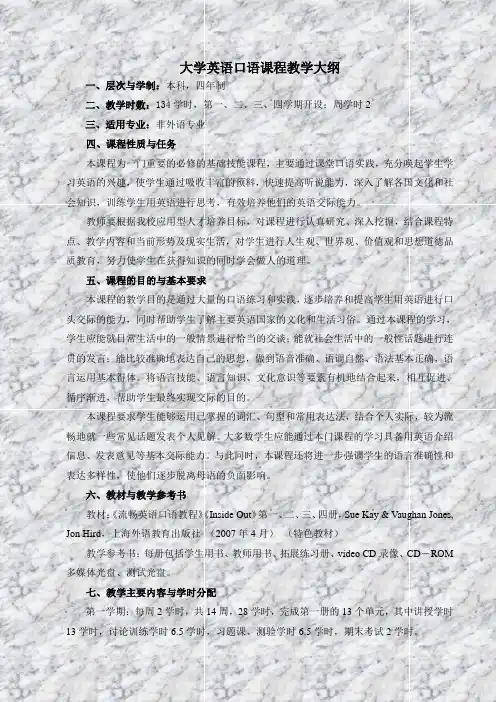
大学英语口语课程教学大纲一、层次与学制:本科,四年制二、教学时数:134学时,第一、二、三、四学期开设;周学时2三、适用专业:非外语专业四、课程性质与任务本课程为一门重要的必修的基础技能课程,主要通过课堂口语实践,充分唤起学生学习英语的兴趣,使学生通过吸收丰富的预料,快速提高听说能力,深入了解各国文化和社会知识,训练学生用英语进行思考,有效培养他们的英语交际能力。
教师要根据我校应用型人才培养目标,对课程进行认真研究、深入挖掘,结合课程特点、教学内容和当前形势及现实生活,对学生进行人生观、世界观、价值观和思想道德品质教育,努力使学生在获得知识的同时学会做人的道理。
五、课程的目的与基本要求本课程的教学目的是通过大量的口语练习和实践,逐步培养和提高学生用英语进行口头交际的能力,同时帮助学生了解主要英语国家的文化和生活习俗。
通过本课程的学习,学生应能就日常生活中的一般情景进行恰当的交谈;能就社会生活中的一般性话题进行连贯的发言;能比较准确地表达自己的思想,做到语音准确、语调自然、语法基本正确,语言运用基本得体。
将语言技能、语言知识、文化意识等要素有机地结合起来,相互促进、循序渐进,帮助学生最终实现交际的目的。
本课程要求学生能够运用已掌握的词汇、句型和常用表达法,结合个人实际,较为流畅地就一些常见话题发表个人见解。
大多数学生应能通过本门课程的学习具备用英语介绍信息、发表意见等基本交际能力。
与此同时,本课程还将进一步强调学生的语言准确性和表达多样性,使他们逐步脱离母语的负面影响。
六、教材与教学参考书教材:《流畅英语口语教程》《Inside Out》第一、二、三、四册,Sue Kay & Vaughan Jones, Jon Hird,上海外语教育出版社(2007年4月)(特色教材)教学参考书:每册包括学生用书、教师用书、拓展练习册、video CD录像、CD-ROM 多媒体光盘、测试光盘。
七、教学主要内容与学时分配第一学期:每周2学时,共14周,28学时,完成第一册的13个单元,其中讲授学时13学时,讨论训练学时6.5学时,习题课、测验学时6.5学时,期末考试2学时。
大学英语口语教学大纲
附件五《大学英语口语》教学大纲一、课程的性质和特点本课程为考查课,配合大学英语及专业课程教学,使学生把握不同社会语境中经常使用的套语,通过形式多样的语言技术训练,能就日常生活中经常使用的话题用比较简单的英语准确地表达自己的思想,以达到在具体的社会语境中得体地利用语言的目的。
二、课程的目的和要求通过一个学期共72课时的教学,使学生在把握了低级英语口语的基础上进一步丰硕所把握的日常句型,能较熟练地进行一样英语会话,较顺利地用英语表达自己的思想,慢慢培育学生叙述、对话、交谈和讨论等方面的口语实际能力。
使学生通过功能句型、典型对话和大量的口头练习,能够具有较强的英语口语表达能力。
三、课时安排(共72学时)四、教学内容Unit OneAim:Require students to grasp different methods of self-introduction and introducing other people.First Days at UniversityI. Warm up.Work with your partner. Discuss which of the greetings are used in the first meting.⒈ Patterns and expressions1) Introducing oneself2) Introducing someone else2. Useful words and expressions1) Work together with your partner to complete the conversations.2) Work in groups of three. Introduce the other two to each other using the patters of Introducing Someone Else.II. Text1. Read the dialogue aloud.2. Make up a dialogue by using the phrases used in the text.III. Pair work1. Develop each of the introductions into short conversations.2. Discuss the following questions.1) Which of the introductions are formal and which are informal?2) What are the possible situations to which they can be applied?IV. Class workIntroduce yourself to at least four people in the classroom.V. Assignment1. Work in groups of six. Make up a chain story according to the pictures, each student talking about one of the picture.2. Talk with three students at English Corner.Unit TwoAim:Require students to learn how to initiate a conversation and shift topics naturally.. Initiating a ConversationI. Warm up.Prepare a short speech to introduce yourself and your roommates based on the guidelines.⒈ Patterns and expressions1) Establishing points of common interest2) Asking polite questions2. Useful words and expressions1) Discuss with your partner and fill in the blanks with appropriate words or phrases according to the given sequence.2) Work with your partner to find a topic of common interest.II. Text1. Read the dialogue aloud.2. Make up a dialogue by using the phrases used in the text.III. Pair workDivide the class into two teams. The first person from Team 1 gives a statement, and his counterpart from Team 2 offers an appropriate response. Then the second, the third … until all the members of both teams have finished. The teacher will be the judge.IV. Group workMove about in the classroom, and talk with at least three of your classmate. Try to shift your topics naturally in each conversation.V. Assignment1. Strike up a conversation with people on campus to seek some relevant information about the topics of the weather or the biggest shopping center in the city.2. Ask each other at least five questions about your families and respond as quickly as possible.Unit ThreeAim:Require students to learn how to ask for necessary information.Knowing Your CampusI. Warm up.Describe the location of the places on campus.⒈ Patterns and expressionsAsking for necessary information2. Useful words and expressions1) Work with your partner and complete the dialogues.2) Present your work to the class.II. Text1. Read the dialogue aloud.2. Make up a dialogue by using the phrases used in the text.III. Pair work1. Extend Conversation 4 and 6 in the text as much as you can.2. Discuss the following questions.1) How to ask the way in a strange city?2) How to direct the way in English?IV. Class workRetell the story to the group, either as the policeman, the judge or the thief. V. AssignmentStory telling.Unit fourAim:Teach students how to congratulate.Happy BirthdayI. Warm up.Make a birthday party invitation.⒈ Patterns and expressionsTalking about a birthday2. Useful words and expressions1) Make up short dialogues using the expressions given in the chart.2) Work in groups of three. One is having his nineteenth birthday party. The other two are invited. Role-play a birthday party.II. Text1. Read the dialogue aloud.2. Make up a dialogue by using the phrases used in the text.III. Pair work1. Have a report about your birthday celebration. The questions below may serve as guidelines.1) When is your birthday?2) What special food do you have on your birthday? Why?3) How did you celebrate your birthday at home?IV. Class workRead the passage and retell the story with your partner.V. Assignment1. Suppose you are going to take part in the birthday party of one of your friends. You are asked to prepare a short speech to be delivered at the party.2. Work out the riddles with your roommates and give an oral report to the class.Unit FiveAim:Require students to grasp how to make inquires and responses.Library and Self-studyI. Warm up.Give an oral introduction of the library to the class.⒈ Patterns and expressions1) Talking to a librarian2) Responses of the librarian2. Useful words and expressions1) Substitution drills2) Role playII. Text1. Read the dialogue aloud.2. Make up a dialogue by using the phrases used in the text.III. Pair work1. Work in groups of four and discuss our learning habit that can be very constructive.2. Make a list about the bad habits of learning.IV. Class workLook at the pictures in the textbook and make a chain story with your partners. V. Assignment1. Discuss the question: “How can we get the most out of school?”2. Give an oral report on your study habit to the class.Unit SixAim:Ask students to grasp the expressions of food.MealsI. Warm up.Talk about the differences and similarities between Chinese food and Western food.⒈ Patterns and expressions1) At an eating place2) Inquires and responses2. Useful words and expressions1) Suppose you are eating with your partner in a restaurant. Make up a dialogue.2) Present your dialogue to the class.II. Text1. Read the dialogue aloud.2. Make up a dialogue by using the phrases used in the text.III. Pair work1. Wok in pairs. One asks the questions, and the other gives answers.2. Retell each of the stories to the group based on the questions.IV. Class workDebate: Which is better, chopsticks or knives and forks?V. Assignment1. Work in groups of five. Each member chooses one of his favorite dishes, and tellsthe group how to cook it.Unit SevenAim:Require students to grasp how to see a doctor and expressions of medicine. Seeing a DoctorI. Warm up.Read the following sayings and explain their implications for medical care.⒈ Patterns and expressionsMeeting the doctor2. Useful words and expressions1) One student acts as a doctor and the other as a patient. Talk to each other using the patterns.2) Change the role.II. Text1. Read the dialogue aloud.2. Make up a dialogue by using the phrases used in the text.III. Pair work1. Extend each of the conversations with more details.2. Present your work to the group and to the class.IV. Class workWork in groups of three. Make the story into a short play.V. Assignment1. Story telling: “I was ill”.2. Oral report.Unit EightAim:Students are required to describe recreational activities they like.Recreation and entertainmentI. Warm up.Name four recreational activities and exchange ideas with partners.⒈ Patterns and expressionsTalking about recreation and entertainment2. Useful words and expressionsPractice the patterns and expressions with one asking and the other answering till you are familiar with them.II. Text1. Read the dialogue aloud.2. Make up a dialogue by using the phrases used in the text.III. Pair work1. Fill in the blanks with proper words and expressions.2. Name each of the things in the pictures.3. Make up a chain story.IV. Class workAsk questions about your partner’s likes and dislikes.V. AssignmentThink of somewhere that would be an ideal place to go on holiday. Introduce theplace to the class.2. Oral report.Unit NineAim:Require students to grasp how to make an appointment and suggestions.A Visit to the Foreign TeacherI. Warm up.Discuss the following questions in groups and report your story to the class.1) Have you ever talked with a foreigner?2) Have you ever visited any of the foreign teachers working in your university?⒈ Patterns and expressions1) Making appointments on the phone2) Making suggestions2. Useful words and expressionsComplete the following conversations, each with a different student in the class. II. Text1. Read the dialogue aloud.2. Make up a dialogue by using the phrases used in the text.III. Pair work1. Practice the text conversations.2. Telephone one of your teachers and make an appointment with him.IV. Class workV. Assignment1. Make suggestions to your friends.2. Work out the riddles in your group.Unit TenAim:Learn good English study methods.English Learning StrategiesI. Warm up.Discuss the difficulties you have in learning English.⒈ Patterns and expressionsTalking about English learning2. Useful words and expressions1) Practice the patterns and expressions.2) Make up a dialogue about your personal experience of English learning. II. Text1. Read the dialogue aloud.2. Make up a dialogue by using the phrases used in the text.III. Pair workPrepare a short speech about your success or failure in English learning. IV. Class workMake a chain story of the pictures in the textbook.V. Assignment2. English Corner: “How do you improve your oral English?”Unit ElevenAim:Students are required to grasp how to express surprise and responses. Back from HolidayI. Warm up.1) Talk about whatever interested and impressed you during the holiday.2) Present your work to the class.⒈ Patterns and expressions1) Seeing a friend after a long holiday2) Using strategic responses2. Useful words and expressionsComplete the short dialogues with proper strategic responses given. II. Text1. Read the dialogue aloud.2. Make up a dialogue by using the phrases used in the text.III. Pair work1. Practice the text conversations.2. Ask each other questions about holiday experience.IV. Class workWork in groups of four and talk about the following topics:1) a family dinner3) taking a holiday jobV. Assignment1. A debate: “Traveling as the Ideal Way of Spending a Holiday”.2. A game.Unit TwelveAim:Require students to learn how to report news.News and issuesI. Warm up.Talk about at least four pieces of news or issues widely discussed in the media or on campus.1)What’s the news about?2)What’s your comment on it?⒈ Patterns and expressions1) Talking about good news2) Talking about bad news2. Useful words and expressionsHave at least three conversations about news and issues with different partners. II. Text1. Read the dialogue aloud.2. Make up a dialogue by using the phrases used in the text.III. Pair work2. Tell a piece of news about the latest development of telecommunications.IV. Class workDescribe the pictures to your partner and to the class.V. Assignment1. Listen, speak and write.2. Research and report:1) newspapers2) magazinesUnit ThirteenAim:Students are required to grasp the vocabulary on latest development in technology.I Like This MachineI. Warm up.Fill in the blanks with the information.⒈ Patterns and expressionsTalking about computers2. Useful words and expressionsMake up a conversation based on the patterns and expressions.II. Text1. Read the dialogue aloud.2. Make up a dialogue by using the phrases used in the text.1. Make up a list of trap words and phrases of your own.2. Give a min-lecture to the class.IV. Class workMake up a role play based on the pictures in the textbook.V. Assignment1. Think it over.2. A debate: “Will computers replace teachers in the future”.Unit FourteenAim:Students are required to introduce famous scenic spots in China. TravelingI. Warm up.Make a short speech to the class about your personal view of traveling.⒈ Patterns and expressionsTalking about traveling2. Useful words and expressionsAsk your partner the following questions:1)When was the last time you traveled by bus?2)Where did you go?3)Did you enjoy the bus trip? Why or why not?II. Text1. Read the dialogue aloud.III. Pair work1. Interview:1) Do you like traveling with friends or alone? Why?2) Which do you like best, traveling by road, by sea or by air? Why?2. Present your discussions to the class.IV. Class workTurn the story into a play and present it to the class.V. Assignment1. Respond properly.2. Make up s story according to the picture in the textbook.Unit FifteenAim:Require students to grasp the etiquette of table manners.Table MannersI. Warm up.3)Talk about the eating habits both in China and in western countries.⒈ Patterns and expressionsPolite requests and responses2. Useful words and expressionsOne uses body language to express the meaning of any word or expression. The other figures out the word or expression that matches the body language.II. TextDiscuss the taboos of eating manners you learned.IV. Class workDebate: “It is necessary to have taboos at the dinner table.”V. Assignment1. Group discussion: the differences between Chinese people and American people in treating their guests to dinner.2. Lecture: How to handle the table setting for western food?Unit sixteenAim:Require students to learn business forms in the western countries: corporation, partnership and sole proprietorship.Private Companies at the CrossroadsI. Warm up.Discuss what are the possible advantages and disadvantages of the family management system for a private company.⒈ Patterns and expressionsTalking about business2. Useful words and expressionsMake up a conversation about private business in china.II. Text1. Try to express the ideas in different ways.2. Tell the story to each other in the first person.IV. Class workFind something unreasonable in the pictures and present it to the class.V. Assignment1. Interview one or two owners of private businesses.2. Role playUnit SeventeenAim:Students are required to grasp the meanings of non-verbal communication.Non-verbal CommunicationI. Warm up.If you don’t know the language of a country, how would you express your ideas?⒈ Patterns and expressionsTalking about gestures.2. Useful words and expressionsDemonstrate a non-verbal signal, and ask your partner to guess the meaning of it. II. Text1. Read the dialogue aloud.2. Make up a dialogue by using the phrases used in the text.1. Discuss the following questions:1) What would it mean if the same gesture were to be made in Chinese culture?2) What would the gesture be like if the same meaning were to be expressed in Chinese culture?2. Facial expressions and emotions.IV. Class workDiscuss and decide who should be given the chance to board the lifeboat, a teacher or a policeman?V. Assignment1. Posture poses2. Make up s story based on the pictures in the textbook.ExaminationAim:Check whether the students have improved in oral English.。
大学英语五英语口语课程教学大纲2021版
*课程目标(CourseObject)
1.学生能够拥有流畅准确、清晰连贯的英语口语表达能力(B1,B2,B5,C1,C2,C4);
2.学生能够拥有用英语讲述中语文化、社会、科技和经济等领域发展成就的能力(A1,A2,A3,A4,A5,D1,D2,D3,D4);
3.学生能够拥有各项英语口试的能力(B2,C2,);
*课程简介(英文)(Description)
Spoken English is a compulsory English course for non-English major freshers who have an advanced level of English.Set at the level of Development according to College English Teaching Requirements (2020),this General English course has students taking the lead in their learning,directed by a knowledgeable teacher,coaching them by their side.The course adopts a task-based and cooperative approach and includes individual and group activities,such as read-aloud,retelling,broadcasting,presentation,acting and dialogue,aiming to enable students to speak English fluently,accurately,clearly,and coherently,and use the language to introduce Chinas social,cultural,scientific and economic development to the western world.
大学英语口语课程教学大纲2
大学英语口语课程教课纲领一、层次与学制:本科,四年制二、教课时数: 134 学时,第一、二、三、四学期开设;周学时2三、合用专业:非外语专业四、课程性质与任务本课程为一门重要的必修的基础技术课程,主要经过讲堂口语实践,充足唤起学生学习英语的兴趣,使学生经过汲取丰富的料想,迅速提升听闻能力,深入认识各国文化和社会知识,训练学生用英语进行思虑,有效培育他们的英语社交能力。
教师要依据我校应用型人材培育目标,对课程进行仔细研究、深入发掘,联合课程特点、教课内容和目前局势及现实生活,对学生进行人生观、世界观、价值观和思想道德质量教育,努力使学生在获取悉识的同时学会做人的道理。
五、课程的目的与基本要求本课程的教课目标是经过大批的口语练习和实践,逐渐培育和提升学生用英语进行口头社交的能力,同时帮助学生认识主要英语国家的文化和生活风俗。
经过本课程的学习,学生应能就平常生活中的一般情形进行适合的谈话;能就社会生活中的一般性话题进行连接的讲话;能比较正确地表达自己的思想,做到语音正确、语调自然、语法基本正确,语言运用基本得体。
将语言技术、语言知识、文化意识等因素有机地联合起来,互相促使、顺序渐进,帮助学生最后实现社交的目的。
本课程要修业生可以运用已掌握的词汇、句型和常用表达法,联合个人实质,较为流利地就一些常有话题发布个人看法。
大部分学生应能经过本门课程的学习具备用英语介绍信息、发布建议等基本社交能力。
与此同时,本课程还将进一步重申学生的语言正确性和表达多样性,使他们逐渐离开母语的负面影响。
六、教材与教课参照书教材:《流利英语口语教程》《 Inside Out》第一、二、三、四册, Sue Kay & Vaughan Jones, Jon Hird,上国外语教育第一版社(2007 年 4 月)(特点教材)教课参照书:每册包含学生用书、教师用书、拓展练习册、video CD 录像、 CD-ROM 多媒体光盘、测试光盘。
英语口语课程教学大纲
《英语口语》课程教学大纲一、课程基本情况课程代码:1101219001课程名称(中/英文):英语口语/Oral English课程类别:外语类通识拓展选修课程学分:2总学时:32理论学时:32实验/实践学时:0适用专业:四年制本科非英语专业(艺术、音乐专业除外)适用对象:四年制本科生先修课程:大学英语(1)、大学英语(2)教学环境:多媒体、网络开课学院:外国语学院二、课程简介1.课程任务与目的英语口语属于外语类通识拓展选修课程。
该课程围绕跨文化交际相关主题,以视听为输入材料的基础上,配以跟读、模仿、角色扮演、对话、讨论、演讲、口译等多种形式的口语练习活动和输出表达形式,通过课堂口语练习和实践,让学生理解单元课文内容并巩固语言点、知识点,充分唤起学生学习英语的兴趣,逐步培养学生用英语进行思考、用英语进行口头交际的意识。
此外,将积极开展课程思政教学改革,将价值引领融入课程任务与目的。
2.对接培养的岗位能力学习内容与现实生活相结合,同时融入语言知识、跨文化意识等要素,使学生深入了解主要英语国家的文化背景、生活习俗和社会知识,培养学生的语言运用能力和跨文化交际能力,为未来入职打下良好的语言基础。
要求学生课后讨论难度更深一层、与主题相关的话题,以发展其对主题内容进行深层次讨论的口语表达能力、创新能力和思辨能力,并最终培养基础理论扎实、具有较强学习能力、实践能力和职业素养的高素质应用型人才。
三、课程教学目标总目标坚持全面发展的育人观,注重学生通用能力和专业能力协同培养。
通过本课程的学习,使学生能够较为清楚、明确地表达个人见解、意见、情感、观点等,较为准确地陈述事实、事件、理由等,就日常生活中的一般情景与来自英语国家的人士进行简单会话,就所熟悉的话题经准备后作简短发言,就社会生活中的一般性或技术性话题进行简单讨论,用简练的语言概括篇幅适当、难度适中的文本或讲话,语音、语调、语法基本正确,语言运用基本得体。
知识目标以应用为目的,以实践为核心,以知识为主线,设计整个课程的教学过程,激发学生说英语的兴趣,培养学生口语表达能力。
- 1、下载文档前请自行甄别文档内容的完整性,平台不提供额外的编辑、内容补充、找答案等附加服务。
- 2、"仅部分预览"的文档,不可在线预览部分如存在完整性等问题,可反馈申请退款(可完整预览的文档不适用该条件!)。
- 3、如文档侵犯您的权益,请联系客服反馈,我们会尽快为您处理(人工客服工作时间:9:00-18:30)。
大学英语口语课程教学大纲一、层次与学制:本科,四年制二、教学时数:134学时,第一、二、三、四学期开设;周学时 2三、适用专业:非外语专业四、课程性质与任务本课程为一门重要的必修的基础技能课程,主要通过课堂口语实践,充分唤起学生学习英语的兴趣,使学生通过吸收丰富的预料,快速提高听说能力,深入了解各国文化和社会知识,训练学生用英语进行思考,有效培养他们的英语交际能力。
教师要根据我校应用型人才培养目标,对课程进行认真研究、深入挖掘,结合课程特点、教学内容和当前形势及现实生活,对学生进行人生观、世界观、价值观和思想道德品质教育,努力使学生在获得知识的同时学会做人的道理。
五、课程的目的与基本要求本课程的教学目的是通过大量的口语练习和实践,逐步培养和提高学生用英语进行口头交际的能力,同时帮助学生了解主要英语国家的文化和生活习俗。
通过本课程的学习,学生应能就日常生活中的一般情景进行恰当的交谈;能就社会生活中的一般性话题进行连贯的发言;能比较准确地表达自己的思想,做到语音准确、语调自然、语法基本正确,语言运用基本得体。
将语言技能、语言知识、文化意识等要素有机地结合起来,相互促进、循序渐进,帮助学生最终实现交际的目的。
本课程要求学生能够运用已掌握的词汇、句型和常用表达法,结合个人实际,较为流畅地就一些常见话题发表个人见解。
大多数学生应能通过本门课程的学习具备用英语介绍信息、发表意见等基本交际能力。
与此同时,本课程还将进一步强调学生的语言准确性和表达多样性,使他们逐步脱离母语的负面影响。
六、教材与教学参考书教材:《流畅英语口语教程》《Inside Out》第一、二、三、四册,Sue Kay & Vaughan Jones, Jon Hird,上海外语教育出版社(2007年4月)(特色教材)教学参考书:每册包括学生用书、教师用书、拓展练习册、video CD录像、CD-ROM 多媒体光盘、测试光盘。
七、教学主要内容与学时分配第一学期:每周2学时,共14周,28学时,完成第一册的13个单元,其中讲授学时13学时,讨论训练学时 6.5学时,习题课、测验学时 6.5学时,期末考试2学时。
项目合计讲授讨论、训练习题课、测验内容Unit 1 Me 2 11/2 1/2Unit 2 Place 2 1 1/2 1/2Unit 3 Couples 2 1 1/2 1/2Unit 4 Fit 2 1 1/2 1/2Unit 6 Shop 2 1 1/2 1/2Unit 7 Job 2 1 1/2 1/2Unit 8 Rich 2 1 1/2 1/2Unit 9 Rules 2 1 1/2 1/2Unit 11 Smile 2 1 1/2 1/2Unit 12 Rebel 2 1 1/2 1/2Unit 13 Dance 2 1 1/2 1/2Unit 17 Animals 2 1 1/2 1/2Unit 18 Weird 2 1 1/2 1/2总计26 13 6.5 6.5第二学期:每周2学时,共17周,34学时,完成第二册的16个单元,其中讲授学时15学时,讨论训练学时8学时,习题课、测验学时9学时,期末考试2学时。
项目合计讲授讨论、训练习题课、测验学时数Unit 1 Friends 2 11/2 1/2Unit 2 Relax 2 1 1/2 1/2Unit 3 Dating 2 1 1/2 1/2Unit 4 Adrenalin 2 1 1/2 1/2Unit 5 Kids 2 1 1/2 1/2Unit 6 News 2 1 1/2 1/2Unit 7 Party 2 1 1/2 1/2Unit 8 Review 1 2 1/2 1/2 1Unit 9 Soap 2 1 1/2 1/2Unit 10 Time 2 1 1/2 1/2Unit 11 Journey 2 1 1/2 1/2Unit 12 Basics 2 1 1/2 1/2Unit 13 Communication 2 1 1/2 1/2Unit 14 Style 2 1 1/2 1/2Unit 15 Age 2 1 1/2 1/2Unit 16 Review 2 2 1/2 1/2 1总计32 15 8 9第三学期:每周2学时,共17周,34学时,完成第三册的14个单元,其中讲授学时13学时,讨论训练学时7学时,习题课、测验学时12学时,期末考试2学时。
项目合计讲授讨论、训练习题课、测验内容Unit 1 Images 2 11/2 1/2Unit 2 Family 2 1 1/2 1/2Unit 3 Money 2 1 1/2 1/2Unit 4 Body 2 1 1/2 1/2复习测验 2 2Unit 5 Ritual 2 1 1/2 1/2Unit 6 Digital 2 1 1/2 1/2Unit 7 Review 1 2 1/2 1/2 1Unit 8 Escape 2 1 1/2 1/2Unit 9 Attraction 2 1 1/2 1/2Unit 10 Genius 2 1 1/2 1/2Unit 11 Sell 2 1 1/2 1/2复习考试 2 2Unit 12 Student 2 1 1/2 1/2Unit 13 Home 2 1 1/2 1/2Unit 14 Review 2 2 1/2 1/2 1总计32 13 7 12第四学期:每周2学时,共17周,34学时,完成第四册的14个单元,其中讲授学时13学时,讨论训练学时7学时,习题课、测验学时12学时,期末考试2学时。
项目合计讲授讨论、训练习题课、测验内容Unit 1 Identity 2 11/2 1/2Unit 2 Taste 2 1 1/2 1/2Unit 3 City 2 1 1/2 1/2Unit 4 Talk 2 1 1/2 1/2复习测验 2 2Unit 5 Luck 2 1 1/2 1/2Unit 6 Mind 2 1 1/2 1/2Unit 7 Review 1 2 1/2 1/2 1Unit 8 Cyberspace 2 1 1/2 1/2Unit 9 Law 2 1 1/2 1/2Unit 10 Firsts 2 1 1/2 1/2Unit 11 Stories 2 1 1/2 1/2复习考试 2 2Unit 12 Words 2 1 1/2 1/2Unit 13 Conscience 2 1 1/2 1/2Unit 14 Review 2 2 1/2 1/2 1总计32 13 7 12八、作业设计要求学生每次课后根据课堂所学内容,结合现实生活,完成一次口头作业或完成每单元的阅读内容。
教师要对每次的作业进行个别抽查,平均每位学生至少有3次检查纪录,作为平时考核成绩的主要依据。
约占平时成绩的30%, 抽查时间由教师自定。
九、教学策略(一)本课程均由来自英语国家的外籍教师担任。
要求外教在课前认真备课,充分了解所授班级的学生状况和英语基础,积极探索行之有效的教学方法。
(二)精讲多练、重视“Sentence Pattern”(句型),“Reiteration”(反复练习),“LanguageEnvironment”(语境)三方面的有机结合。
英语句型结构的分析运用是学习英语的重要基础,要求学生利用教材中的替换练习形式,用所学过的常用词汇,替换变衍出自己所需表达的意思,从而系统地掌握各类基本句型的运用规律。
(三)注重语言运用能力的培养,提高学生口头交际能力本课程的基本手段是通过让学生接触到大量的与情景相应的有声语言,增加语言输入,然后经过对语言的模仿最终达到对语言的自如运用。
因此,第一、二学期应着重于语言基本功的训练,如语音、语调、语法、朗读、复述能力。
第三、四学期则着重于让学生用所掌握的基本的语言知识,条理清晰、逻辑严谨地口头表达观点与思想。
在两个学年的学习中,学生应从大量的口语实践中完成从单纯模仿语言到自由运用语言的过渡。
(四)培养学生的跨文化交际意识语言是文化交流的媒介,交际过程无时无刻不体现着文化之间的差异。
本课程的目标还在于帮助学生了解主要英语国家的文化背景和生活习俗。
在教学中要引导和帮助学生了解英语国家的社会、文化习俗,理解交际过程中众多因素(如:场景、功能、意念、性别、社会、心理、风格、情感)与语言得体性的关系,使其掌握正确、得体的表达方式。
(五)提高学生分析问题的能力本课程的素材取材于当今美国社会生活,内容新颖,生动,涵盖了日常生活,学习中的各种对话场景。
充分体现了当今美国语言与美国文化。
它一方面为学生提供了丰富的有关英语国家的资料;另一方面也为学生展示了外国人对社会诸方面问题的看法。
口头实践活动应与提高学生分析问题的能力有机地结合起来。
(六)积极开展课外活动口语能力的提高需要大量、反复的实践,课堂教学应与课外活动结合起来。
要搞好英语口语课的教学,不能只局限于课内的辅导,还要创造条件引导学生开展丰富多彩的英语课外活动,如英语角、英语演讲、英语竞赛等形式多样的课外活动,使学生有更多的运用英语的机会,以便提高学生参加口语练习的兴趣和积极性。
十、考核方式(一)本课程为各学期的考试课。
采取口试的方式进行。
(二)成绩比例为:平时考核占50%和期末考核占50%。
(三)平时考核成绩的评定要根据学生的出勤情况、完成作业的情况、口语课上的综合表现情况而定。
(四)期末考核:期末考试每学期安排一次,任课教师命题。
命题原则:结合课堂授课内容,考察学生实际运用语言的能力。
十一、教材的删减与增补删减:第一册第五、十、十五、十六、十七、十九和二十单元删掉,其中第五、十、十五和二十单元为复习单元。
另外,教材中的语法部分、写作部分以及阅读部分不作为重点的教学内容。
教师可根据所教班级的实际情况酌情使用。
增补:教师在完成教学任务的基础上,可根据学生的实际情况,给学生补充一些与所授课程内容相关的课外辅助材料或相关的背景知识介绍来丰富教学内容。
教师应在教学中联系实际,把最新的有关世界和中国的新闻报道融进教学之中,帮助学生开阔眼界,使学生能够真正做到学以致用,不脱离生活实际。
